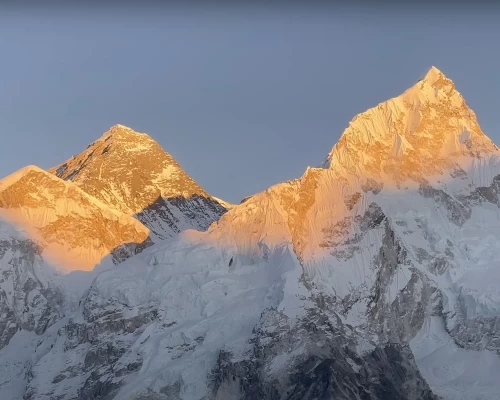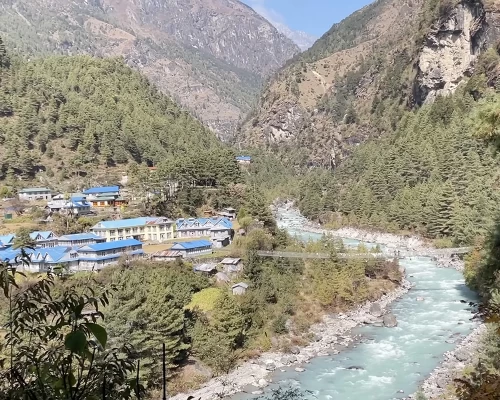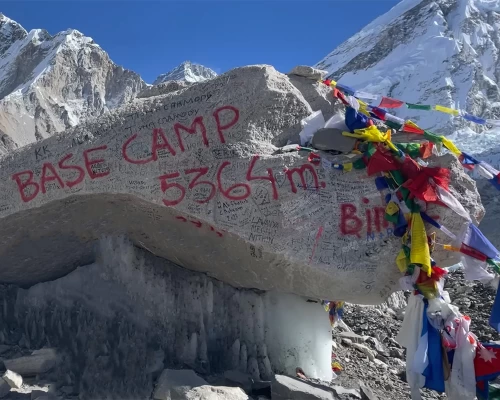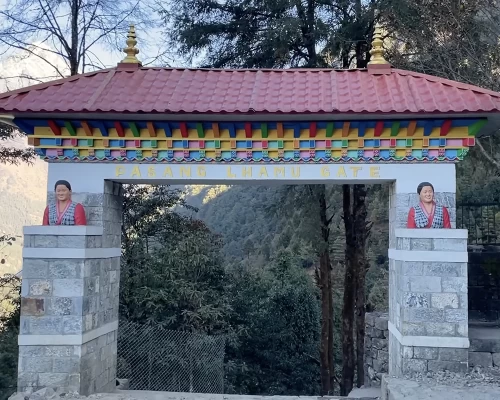The Success of climbing to the top of the world starts at Everest Base Camp and trekking to this magical starting point is a dream come true for thousands of visitors entering Nepal. Trekkers start from the rich heritage of Kathmandu and take a flight to Lukla (Tenzing Hilary Airport) to enter the beautiful Khumbu region, this is where the journey begins.
During the voyage, you will be exploring the beautiful scenery of the Khumbu region of Nepal which lies under Sagarmatha National Park. Discovering the wildlife and emerging from the culture and lifestyle of Sherpa to walking on a tough and rugged Himalayan terrain, you will uncover the mystery of nature and its relation with humans in one place.
You will be crossing numerous suspension bridges and wooden flanks on the way and stuck in the traffic of the yaks with the soothing music of their bells. The glowing mountain range shines and calls you closer as Gumbas (Monasteries) and Chhortens will provide you with a wonderful spirituality. The culture and customs of Sherpa and their warm hospitality will be your home during the trekking days. With these incredible moments, you will suddenly realize that you have reached Everest Base Camp at 5346 meters trekking through the alpine terrain. One of the most beautiful moments of the journey is reaching Kalapatthar at 5550 meters, which offers the best view of Mount Everest (8848 meters), Lhotse (8516 meters), and Nuptse (7861 meters).
Trails on your Everest Base Camp route are organized and well-marked nowadays, we can see the numbers of the crew moving to base camp and coming back from there. This trek is not just about the view of Mount Everest, equally beautiful Ama Dablam (6812 meters), Makalu (8481 meters), Cho Oyu (8188 meters), Thamserku (6608 meters), Pumori (7161 meters), and more keep you engaged.
Getting in and Away
The typical route for getting in and away from the Khumbu region involves:
Option 1
Step 01 Fly from Kathmandu to Lukla (Tenzing-Hillary Airport).
Step 02 Begin the trek from Lukla to Everest Base Camp.
Step 03 Retrace your steps back to Lukla.
Step 04 Fly from Lukla back to Kathmandu.
Option 2
Step 01 Drive to Jiri and trek for a few days to reach Namche Bazaar.
Step 02 Follow the route to Everest Base Camp.
Step 03 Retrace your steps back to Lukla.
Step 04 Fly from Lukla back to Kathmandu.
Keep in mind that flight schedules and availability are subject to weather conditions, so it's essential to remain flexible and prepared for possible changes to your travel plans.
What to Expect while trekking to Everest Base Camp
Himal Reisen has completed more than a hundred successful trekking campaigns with a trained and active local guide from the Himalayas. they will assist you in every step of your 14 days trek leading to Everest Base Camp. We will arrange a porter for 2 pax and they will carry 10 to 12 Kg of your backpack. Our team assures you have wonderful service and hospitality and provide everything included in the package.
Looking back at history trekking in Khumbu was challenging and active adventure enthusiasts have to hike for several days to find a way to reach Everest Base Camp (EBC), carrying lots of equipment, Food, and camping arrangements with the instance of Sherpa Guides.
Now, there are hundreds of Tea Houses and Lodges in the Khumbu region providing great hospitality for trekkers for a comfortable journey to EBC, these accommodation providers will arrange all of the meals that work best for your appetite.
The weather during your trekking days to Everest Base Camp changes frequently, it is not guaranteed that you will see a clear view of the Mountains and surrounding. You will experience several weather conditions each day. Morning and night can be too cold as a day can be extremely warm. Sometimes the climate might not be in your favor. To avoid this one of the best practices is to choose the right season and time.
Is this trek appropriate for you?
Suitable for enthusiasts with a spirit of adventure, there are not any criteria to join Everest Base Camp Trek. Experience, preparation, and information are key to the high-altitude trek. If you are among someone consistent with physical strength and hiking, or traveling around you will experience a mediocre difficulty. The average person can perform a minimum preparation and achieve the journey however those who do not have experience have to carry some weight on their back and train well. This trek has recorded kids and older people complete due to their confidence and focused preparation.
For those with health issues such as Asthma, Low pressure, breathing issues, or any critical health conditions, we suggest taking guidance from family doctors to ensure you can safely complete the trek to Everest Base Camp.
Tips to Prepare for your trekking
It is a modest yet extensive process to prepare for your trek, as Everest Base Camp is a difficult journey and takes longer days to complete one must start training at least 4 months before the departure date.
First of all, it depends upon your physical strength, if you are a gym guy or athlete, or continuously exercising and performing any activities like morning or evening walks, cycling, etc. this trek is going to be easy for you, and focusing on mental preparation and some breathing exercise and yoga can almost get you prepared. If you are not continuously focused on these activities, you have to perform any of them regularly.
One of the best ways to train ready for the Everest region is to hike a nearby altitude, you can check the highest point nearby your location and carry a backpack of more than 5 kilograms and join the trail. If you do this weekly, you will be ahead prepared than your fellow travelers, and reaching base camp can be way easier than you think.








